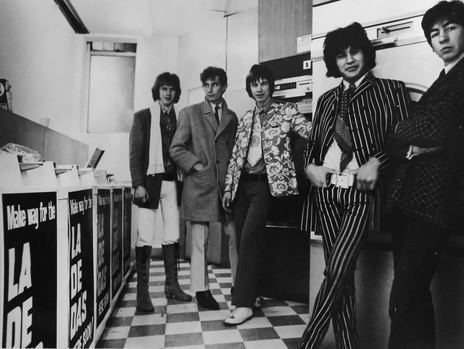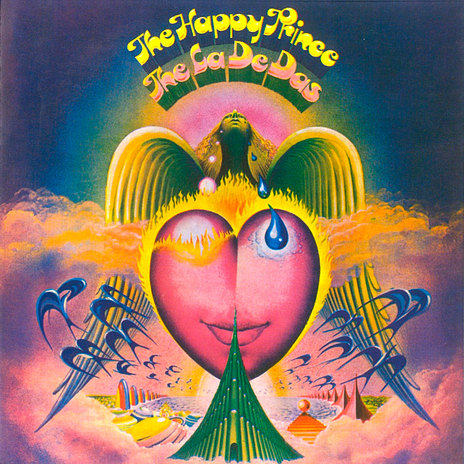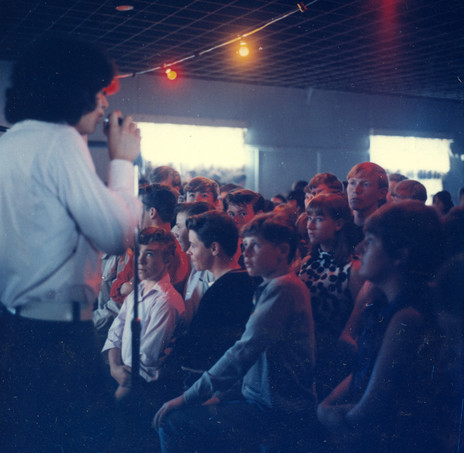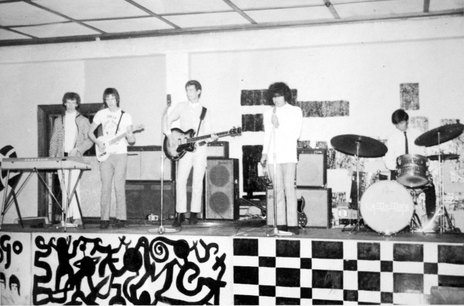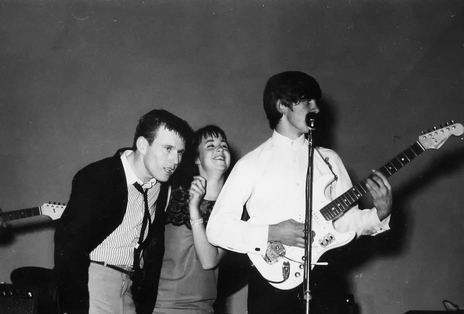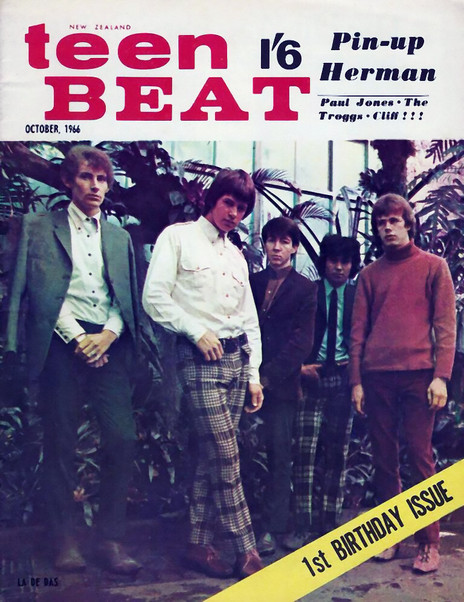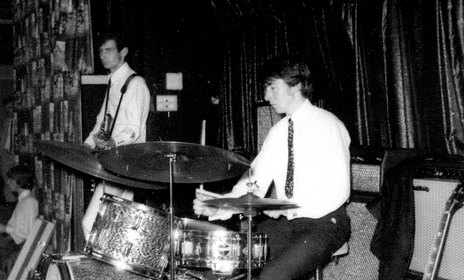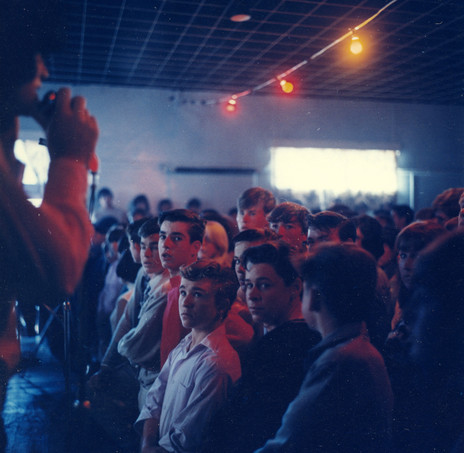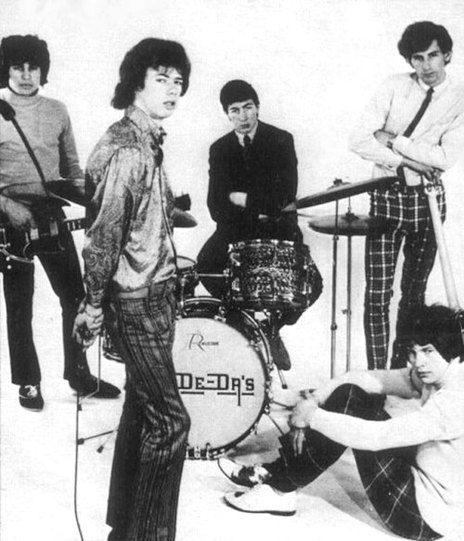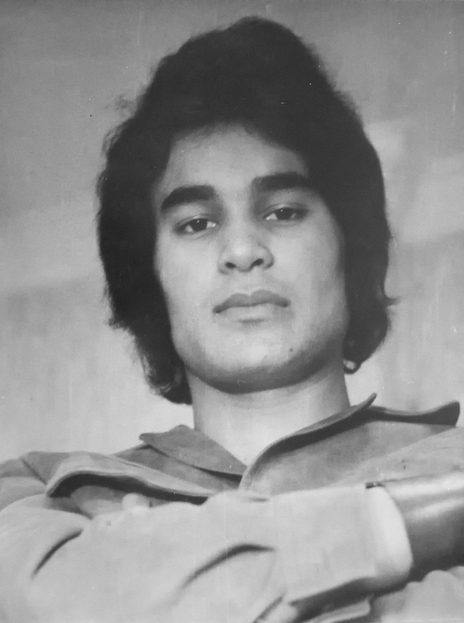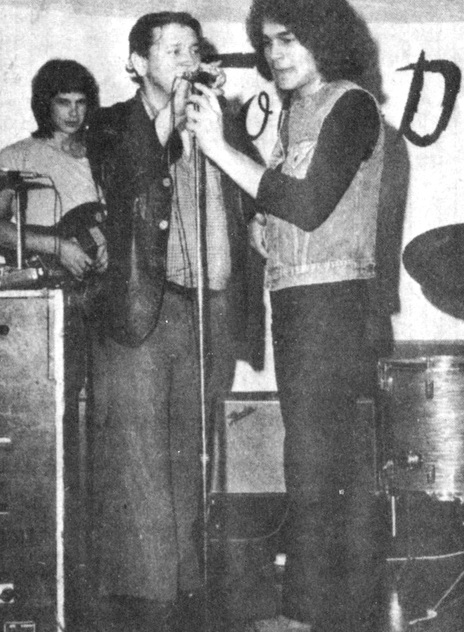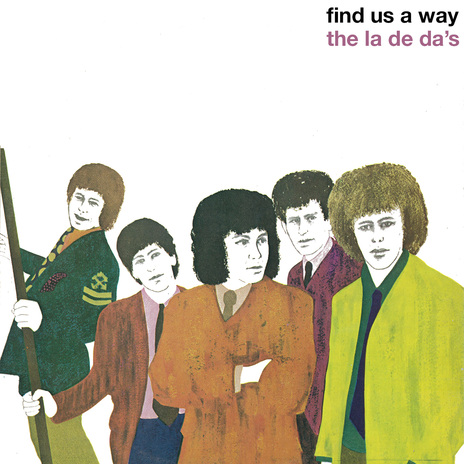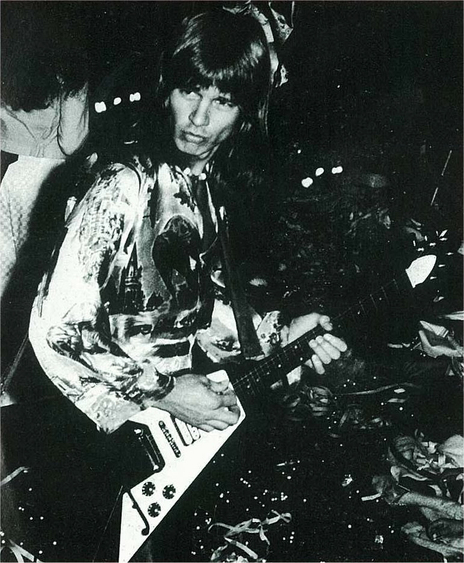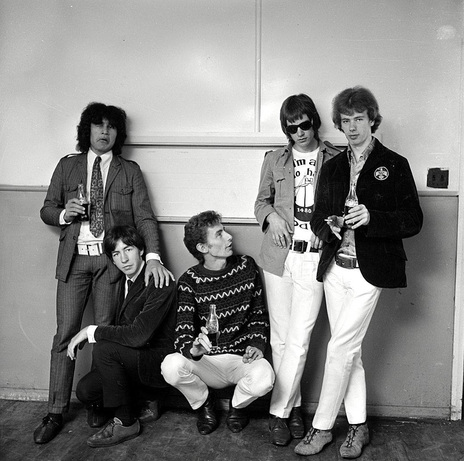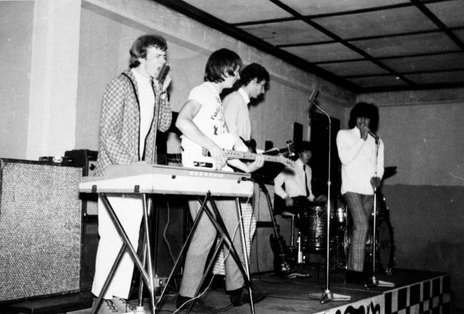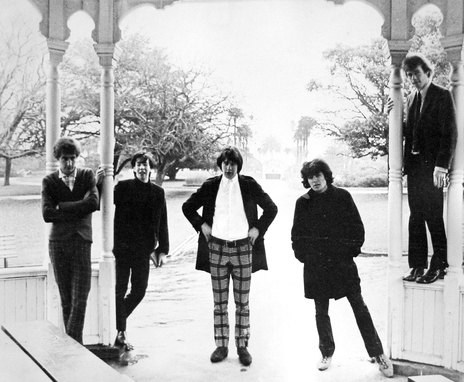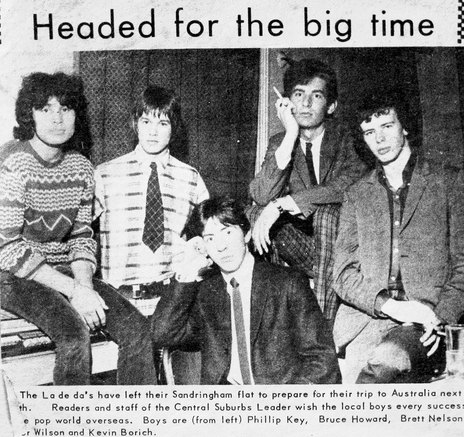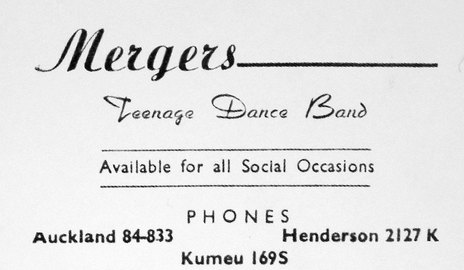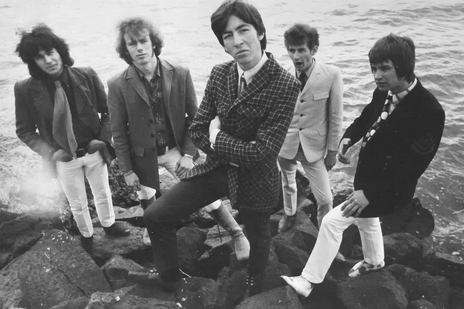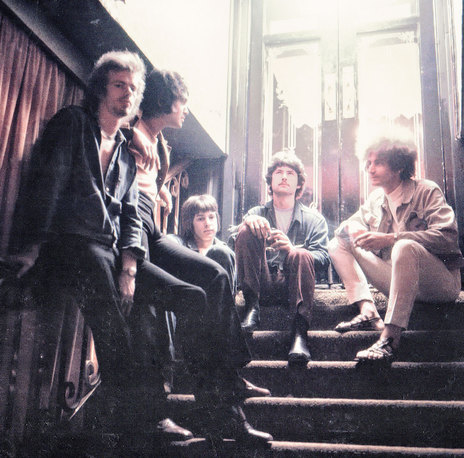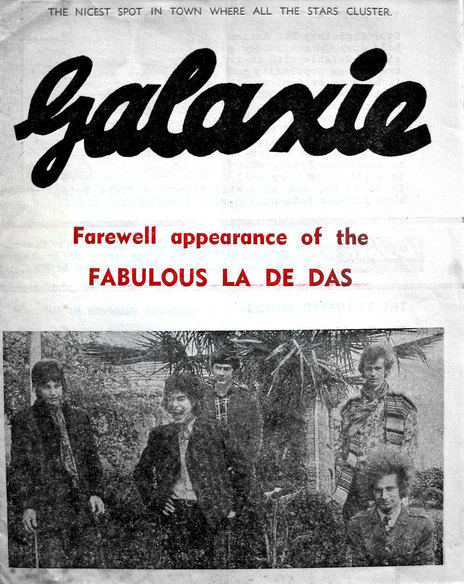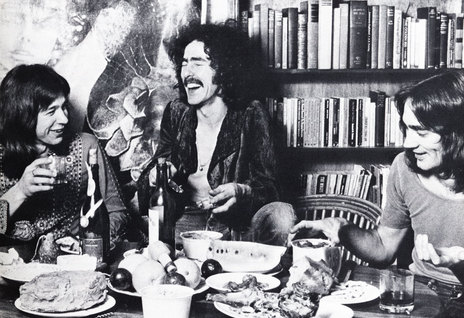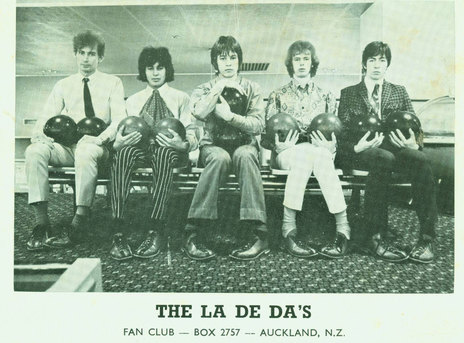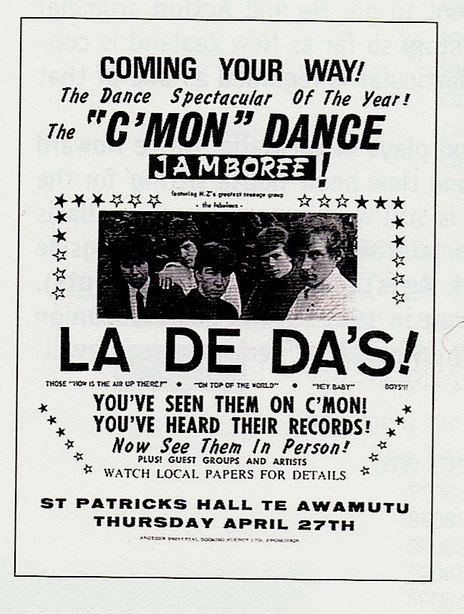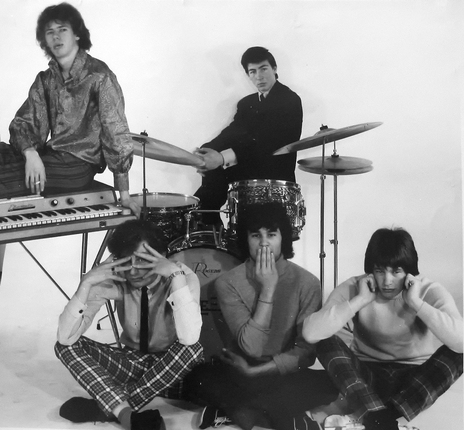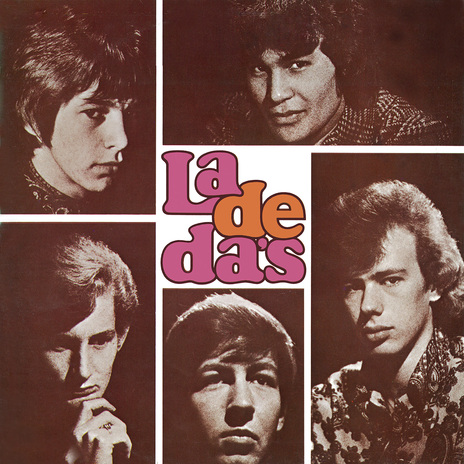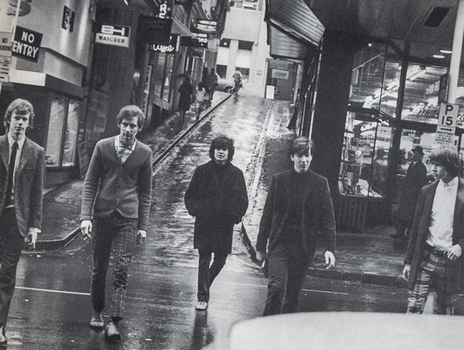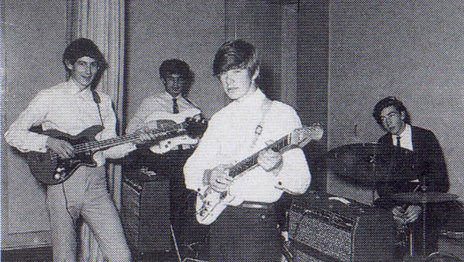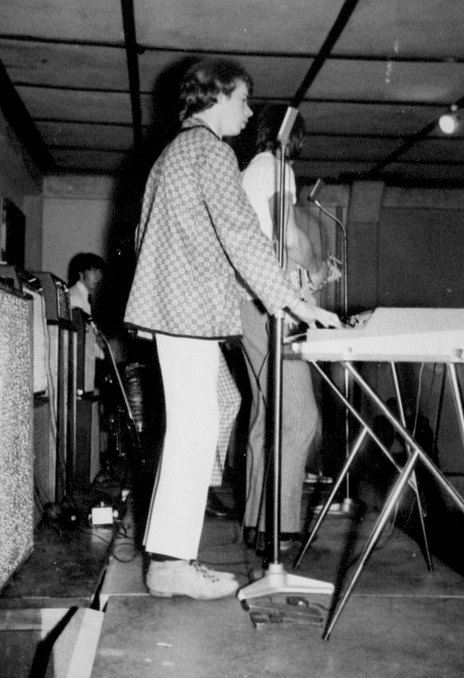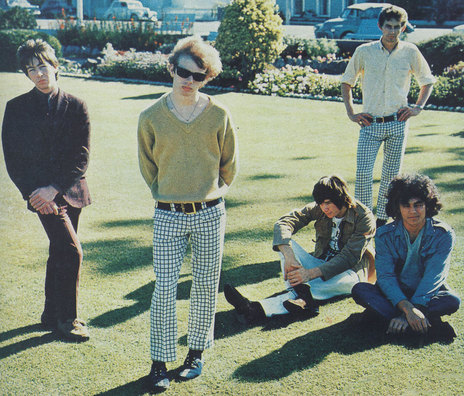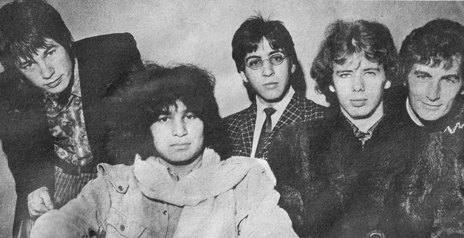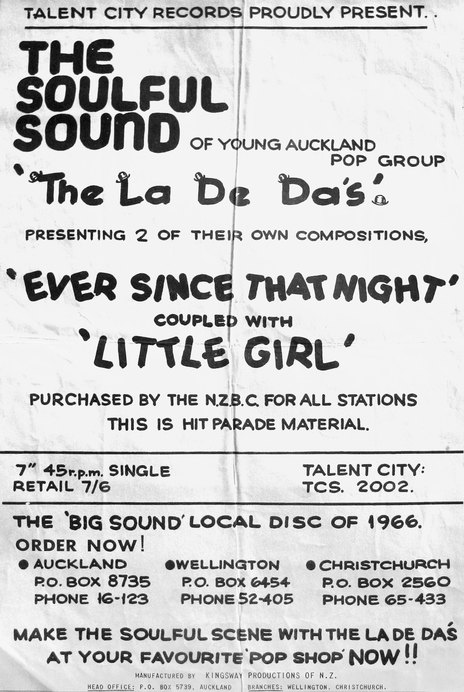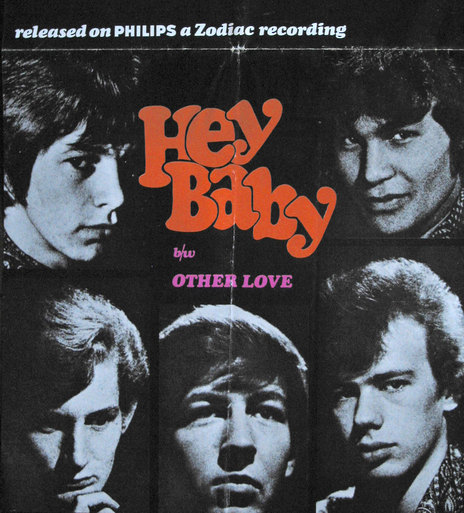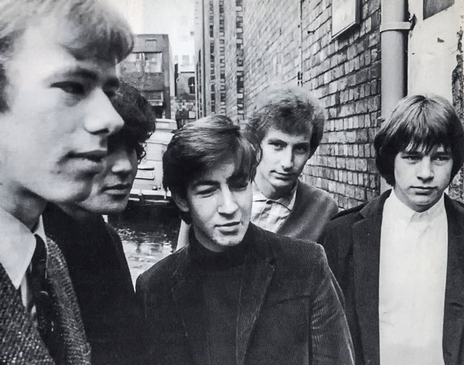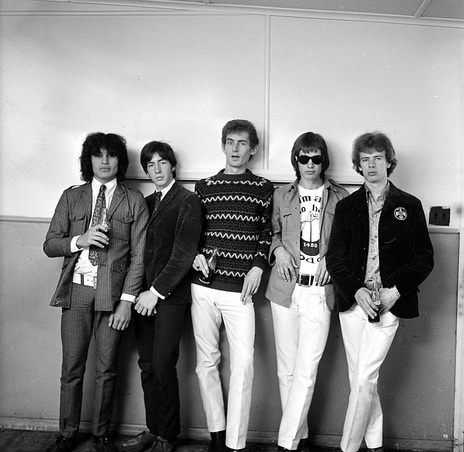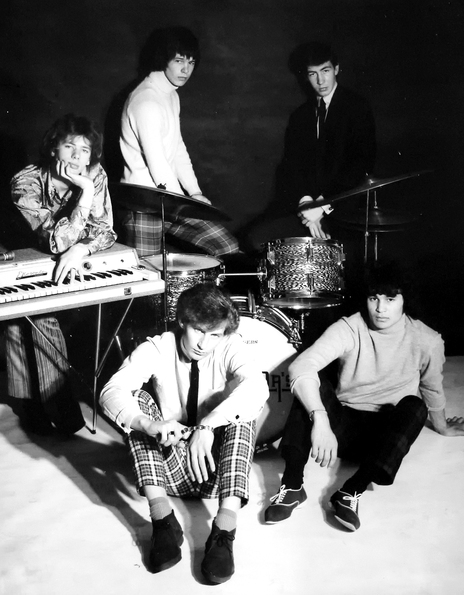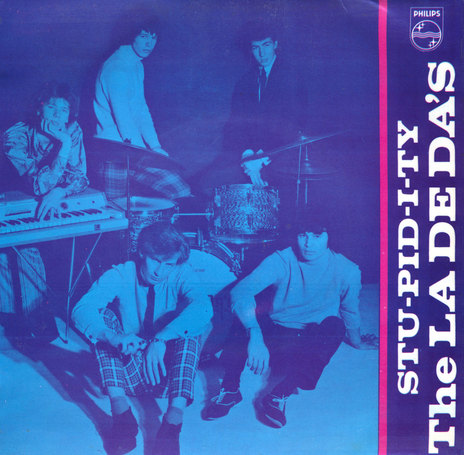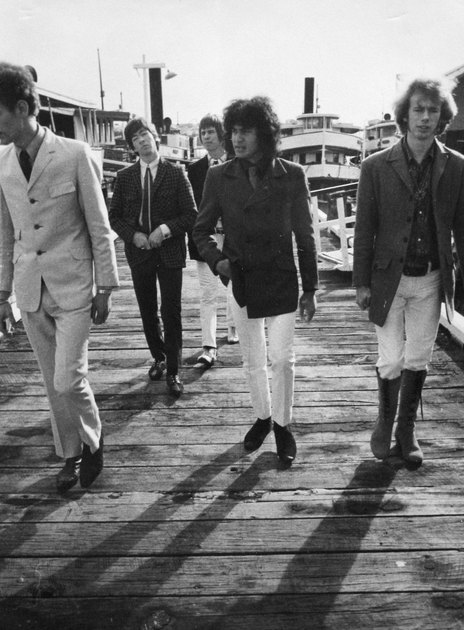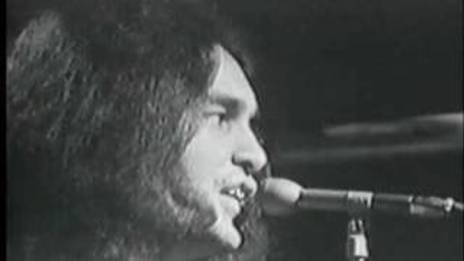By the time the Auckland band went their separate ways in the early 1970s they were a chart group once again and considered among Australasia’s best.
Don’t You Stand In My Way: The La De Da’s versus the world – 1964-1975
The new wave of R&B was already breaking big in charts across the world when four of its best practitioners – The Kinks, Manfred Mann, The Rolling Stones and The Pretty Things – rolled through New Zealand in 1965 for a series of concerts still vividly recalled decades later. The raw pull of the sound and the style and ethos of the players galvanised local teenagers, throwing up a large and responsive audience to be serviced by the likes of The Unknown Blues in Invercargill, The Third Chapter in Dunedin, Peter Nelson and The Castaways and Chants R&B in Christchurch, Bari and The Breakaways and Tom Thumb in Wellington, The Mods and The Trends in Hamilton, and The Dark Ages and The La De Da's in Auckland, along with dozens of lesser lights.
While beat music provided a new soundtrack to teenage lives, the group aesthetic and anti-social veneer of R&B offered up an alternative lifestyle to teenage fans – and a good living, local fame and the distant lurking prospect of a hit for groups – by pushing a covert message that being uncompromising not only paid, it gave you the freedom to behave in the way you wanted. Teenage heaven.
In West Auckland at Te Atatu’s newly opened Rutherford High School, were the mod-ish Mergers with Kevin Borich (lead guitar/vocals), Trevor Wilson (bass), Brett Neilsen (drums) and Phil Key (rhythm guitar/vocals) who attended Mount Albert Grammar. They had heard the word and flirted with an anti-social name, The Criminals, before settling on the provocative ambiguity of The La De Da’s.
Establishing an immediate following through hall and club dates, they stepped into a residency at inner city teen club The Platterack in April 1965. That’s where NZBC producer Robert Handlin found them and soon became their manager, releasing Kevin Borich’s folkie ballad ‘Ever Since That Night’ backed with the Borich/Wilson penned R&B of ‘Hey Little Girl’ on his Talent City label in June.
The emerging group soon found space in their ranks for classically trained organist Bruce Howard, who swelled their sound and added another vocalist. With guitar whiz Kevin Borich picking out the leads, they had a strong rhythm section in Wilson and Neilsen with Phil Key on rhythm guitar. And when Samoan New Zealander Key came out of his shell, he revealed one of New Zealand’s finest R&B and soul voices.
Signing to Zodiac
By February 1966, now signed to Eldred Stebbing's Zodiac label, The La De Da’s were in Stebbing's Auckland studio with producer John Hawkins, recording ‘How Is The Air Up There?’. The song now most readily identified with them is usually mentioned as a Blues Magoos cover. However, The Blues Magoos never recorded the song and was most likely sourced from US folk pop group The Changin’ Times, who released it as the follow-up to ‘The Pied Piper’, a version of which was on the flip of The La De Da’s’ hit single. Both songs were written by The Changin’ Times’ Artie Kornfeld and Steve Duboff.
Success didn’t mellow The La De Da's. They were right back in your face with their third single, the hard swinging R&B of ‘Don’t You Stand In My Way’, a Bruce Howard/Trevor Wilson original backed by the pumping soul of Sam and Dave’s ‘I Take What I Want’, which was also released by Philips Records in Great Britain, Australia and the USA via a deal with Zodiac.
A creative triumph it may have been, but it was also a chart mis-step that was quickly redeemed by another cover, the slow fuzzed R&B of John Mayall’s ‘On Top Of The World’, which threatened the top of the New Zealand charts in November 1966.
At the Galaxie Lounge, THE LA DE DA’S sharp stage set, live verve and impeccably tailored look established them as one of Auckland’s top groups
With two hits under their finely styled belts, The La De Da’s stepped up to a residency at the harbourside Galaxie Lounge, where their sharp stage set, live verve and impeccably tailored look – by Jerry at His Lordships – established them as one of Auckland’s top groups. While no film or live recordings exist of the group in their early prime, you need only slap the much-reissued first La De Da’s album from December 1966 onto the record player to get a taste of what Auckland fans heard.
Lead track ‘On Top Of The World’ was a John Mayall & The Bluesbreakers song, first recorded three months after Eric Clapton joined in June 1965. Jimmy Page was the producer. ‘My Little Red Book’ was a Burt Bacharach tune made popular by Manfred Mann and LA group Love who edged it to No.52 in the US charts in March 1966. Manfred Mann’s version, released in April 1966, is a more likely source for the song.
‘Jump Back’, ‘Bright Lights, Big City’ (sung by Phil Key) and ‘I Put A Spell On You’ (sung by Kevin Borich) are R&B standards taken from Rufus Thomas’ October 1964 Atlantic single and Jimmy Reed and Screaming Jay Hawkins (1956 Okeh Records) respectively. They were all songs covered by British R&B groups, which is likely where The La De Da’s copped their versions. ‘Whatcha Gonna Do About It?’ was a recent R&B hit for group faves The Small Faces.
Wilson Pickett's frantic soul hit ‘Land Of A Thousand Dances’ was a No.6 hit in 1966 on Atlantic Records. ‘I Take What I Want’ was a Stax/Atlantic hit for Sam and Dave, although, The La De Da’s version was most likely taken from The Artwoods' fourth single released on Decca in April 1966.
‘Shake’ – a Sam Cooke 1965 No.7 for RCA Victor – was another Small Faces cover and a No.3 hit single from the first Small Faces album from May 1966. The La De Da’s returned to John Mayall’s Bluesbreakers for ‘Parchman Farm’ (a John Mayall solo), originally released in September 1966. ‘The Pied Piper’ I’ve already mentioned.
Rounding out one of our finest 1960s albums is Muddy Waters' ‘I Got My Mojo Working’ (sung by Kevin), and ‘Ride Your Pony’, a foot-down R&B screamer sung by Phil Key which was written by Allen Toussaint and originally released by Lee Dorsey on Amy Records in 1965, when it became a No.28 hit in the US.
And just in case the fans still didn't get the point, The La De Da’s unleashed a live EP called Stupidity in April 1967.
Finding the way forward
Having shown their knack and feel for interpretation, and with a good grasp on the best music coming in from overseas, Auckland’s finest R&B group dipped into their own strong collection of songs in May 1967 for successful follow-up album Find Us A Way. They were billing themselves live as “Soul Blues”, which nicely sums up the churchier, more gospel feel of their new record. While the band still found a frantic sweaty beat on ‘Find Us A Way’, ‘I Gotta Woman’, ‘Tell The Truth’, ‘Cool Jerk’ and ‘Gimme Some Lovin’, they left room for the sunny pop of ‘Sonny Boy’ and spacier keyboard-led originals ‘All Purpose Low’, ‘Thank You For The Flowers’, ‘Rosalie’ and ‘Beside Me Forever’. Meeting the two strands in the middle was the fine organ-led, gospel inclined soul of ‘Goodbye Sisters’ – a take on The Artwoods' third single from April 1965 – and their version of The Marvelettes’ ‘Too Many Fish in the Sea’ from 1964.
The heavy nature of The La De Da’s NZ-recorded covers reflects the importance of interpretation in the 1960s and echoes the similar makeup and musical influences heard on early records by The Beatles, The Rolling Stones and The Kinks, amongst others. The care taken to find rare B-sides and album tracks or songs that were minor or non-hits, and therefore contemporary, chart-minded and accessible to Kiwi musicians, is similarly an echo of other groups who fished around in rare back catalogues for material.
The La De Da’s spent 1967 managing themselves, running their fan club and touring, including a long national jaunt in January alongside frequent appearances on the new and influential live pop TV show C’mon. The group’s pop currency was still high after another massive No.1 hit in March with a laidback version of Bruce Channel’s ‘Hey Baby’, a song recommended by blind pianist and former Johnny Devlin and The Devils member Claude Papesch one night at the Galaxie Lounge.
Making it in Australia
With four hit singles, two classy albums and a national following behind them, The La De Da’s set out for Sydney.
Their first two singles had been released across the Tasman, but with pop’s menu changing daily they had quickly fallen from view. The independent quintet struggled, finding their R&B and soul based set outdated. They also bristled at micro-management and unsuccessful recording attempts, despite gaining fans at Ivan Dayman’s Op Pop disco.
The independent quintet struggled, finding their R&B and soul based set outdated.
They flopped even worse on the strong Melbourne club circuit before heading home in September 1967 for a month-plus residency at 1480 Village in the old Top Twenty premises in Auckland, where they retooled their set and sound before touring New Zealand. Godzone hadn’t forgotten them, sending ‘All Purpose Low’ to No.5 in June and ‘Rosalie’ to the same spot in August.
In January 1968, Brett Neilsen left the group, replaced by The Action’s Bryan Harris, who gave way on the group’s return to Sydney in June to Australian drummer Keith Barber (The Wild Cherries). Wielding a wide and eclectic array of instruments and introducing Sydneysiders to The Doors, Vanilla Fudge, Traffic and The Band, this was the psychedelic La De Da’s, and their heady themed sets immediately caught on.
Back on the front foot, they returned to Melbourne in August 1968 with the show they had wowed Sydney with. This time the city fell for their charms, sparking a long and close relationship with the Victorian capital’s music scene. At year’s end they were voted Australia’s Best Disco Group in popular music magazine Go Set.
Rock operas and London
Better was to come in 1969. ‘Come and Fly With Me’, their first single since mid-1967, was an upbeat burst of good feeling and the standout track on The Happy Prince, the rock opera on based on Oscar Wilde’s short story, which Trevor Wilson and Bruce Howard had long been working on. The ambitious project had finally found firm ground in January with the group entering EMI studios in Sydney with producer David Woodley-Page and narrator Adrian Rawlins to record for an April release.
Rock operas were thick on the ground by then, and while the opera created by The La De Da’s had its highpoints in Kevin Borich’s slide guitar and Phil Key’s soul-gospel vocals, the songs too often struggled to elevate the storyline. (Read the background story to the recording of The Happy Prince.)
None of the band ever dismissed it. It was an artistic statement they needed to make. But now it was done, they set their sights on London – a trail well-worn by New Zealand and Australian groups.
Finding their set out-dated and record company interest in London lukewarm, it was Melbourne the first time all over again – a comedy of missed opportunities and half chances. The La De Da’s performed little outside of a short tour of West Germany, and recorded only once, a menacing take on The Beatles’ ‘Come Together’ taped with Norman “Hurricane” Smith at Abbey Road Studios for Parlophone Records, which was released in Great Britain (as The La De Dah Band), Australia and New Zealand.
A moment to regroup
Down, but not out, they headed home in February 1970 and regrouped with new bass player Reno Tehei (Sounds Unlimited/Compulsion), then refocused their repertoire and settled into a booming Australian circuit energised with the opening of pub venues and the sparking of large outdoors festivals.
All that travel inevitably took a toll on the group’s stability. Trevor Wilson remained in England and wouldn’t return until October. When he did, the group fractured, first with Bruce Howard, then everyone except Wilson departing.
Wilson didn’t want to start all over again, leaving the remaining La De Da’s to claim the name. Managed by Phil Key, they headed out on the live circuit with new bassist Peter Roberts and a core set of hard-rocking blues and boogie.
Bruce Howard soon joined The Clefs and went on to one of Australia’s biggest groups, Billy Thorpe and The Aztecs, where he was a key member in 1972 and 1973. Trevor Wilson joined fellow New Zealand veterans Glyn Mason and Mal Logan in Sydney-based Home in early 1972, pushing what Australian music historian Ian McFarlane called “a light and nimble country rock with a clean blues edge.”
The La De Da’s meanwhile set about building a dedicated live following for their hard, blues-based rock. This time, pop culture’s fast flowing current was running their way. Billy Thorpe and The Aztecs had opened up a successful circuit of big live rooms in Melbourne’s suburban pubs and the public’s taste for bigger festival events was rising. The group took on Sydney-based Michael Chugg as their manager in November after he signed them to his new booking agency Sunrise, then released their first Australian hit record, the Borich-sung, Howard Gable-produced, locomotive blues of ‘Gonna See My Baby Tonight’, which spent eight weeks in the Go Set National Top 20 between November 1971 and February 1972.
Their take on Bob Dylan’s ‘All Along The Watchtower’ became a signature live song.
It was only one of a number of distinctive songs that The La De Da’s got down that year. Their take on Bob Dylan’s ‘All Along The Watchtower’ became a signature live song, and they captured a studio version with Bruno Lawrence drumming, which would appear belatedly on 1976’s Legend compilation. There's also a fine live-for-TV interpretation featuring a haunted Phil Key vocal and biting Borich guitar lead, filmed for Melbourne magazine show, GTK (Get To Know).
The rock festival era
After cancelling a New Zealand tour in November 1971, The La De Da's fronted up at Rosebud, a Melbourne free festival, which drew 40,000 fans to Mornington Golf Course at Christmas to hear Billy Thorpe and the Aztecs and Daddy Cool. It was a dress rehearsal for what was to come. In the early 1970s live music spilled from city clubs into summer festivals in the surrounding countryside, and The La De Da’s nearly always played. They were there at the successful first three-day Sunbury festival outside the city on Australia Day long weekend in January 1972, which showcased Melbourne’s rock and roll talent and community, and New Zealand musicians’ prominent place in it.
As one of the festival’s highpoints, The La De Da’s had three songs – their upcoming hit single ‘Morning Good Morning’, the dynamic blues rock of ‘Roundabout’ and their 1971 hit ‘Gonna See My Baby Tonight’ – included on EMI Records’ Sunbury live album, from a set which included ‘Carol’, B.B King’s ‘Rock Me Baby’ and Traffic’s ‘Give More Than You Can’.
The La De Da’s didn’t linger at Sunbury long. The same weekend they had a festival date at Meadows Technicolour Fair in Adelaide in South Australia where they performed before 30,000 people. Again, New Zealand musicians were thick on the stage with John Bissett in Fraternity, Wellington’s Highway, and Spectrum and Friends wowing the crowd.
Six weeks later on March 12, The La De Da’s helped break Australian attendance records at a free 3XY concert at Melbourne’s traditional Moomba festival at Myers Music Bowl. Three weeks after that, on Easter weekend, they fronted the Mulwala Festival midway between Sydney and Melbourne, which no doubt helped push their festival anthem, the Phil Key sung, ‘Morning Good Morning’, into the Australian charts in May for a 10 week run, peaking at No.17.
And then there was one
When The La De Da’s closed the year out at the Bungool Festival of Music outside Sydney with Band of Light, Bakery, Home, Spectrum and Sherbet before a disappointing crowd of 2,000 people, they were a three-piece with sole remaining member and Go Set best guitarist winner Kevin Borich in charge, backed by Ronnie Peel on bass and Keith Barber drumming. Phil Key and Peter Roberts had jumped ship in September, forming Band of Light with ace slide guitarist Norm Roue and experienced drummer Tony Buettel after arguments over money and frustration that Key’s songs weren’t being played live. Roberts soon departed, replaced by Ian Rilen.
The stripped down La De Da’s had boogied on, playing out again by November and supporting Manfred Mann Chapter Three, Little Richard, The Guess Who, Gary Glitter, Lindisfarne and Three Dog Night. They were a massive hit back home in January 1973 at The Great Ngaruawahia Music Festival, returning on the back of the buzz generated for a successful national tour in April.
Roy Colbert, writing for New Zealand Rolling Stone caught up with them in Dunedin, asking Borich about the trio’s drug consumption – no dope or acid in the mid-1960s but he noted there was now plenty of acid around – and he revealed the group had been stalling on doing anything with EMI Records to get out of the contract, but were now working on the blues-boogie Rock And Roll Sandwich album, which would be released in November, following non-charting single ‘The Place’. Recorded live at Doncaster Theatre in Kensington and tidied up at EMI studios in Sydney by expat New Zealand producer Rod Coe, the album showed Borich firmly in charge, augmenting his searing blues guitar with flute and piano.
A subtler La De Da’s can be heard that year, backing folkie cum street rocker Richard Clapton on the bright and breezy funky blues of ‘Hardly Know Myself’ (B-side to ‘All The Prodigal Children’ October 1973) and providing a wordy, weary-eyed blues shuffle with sparking Borich solo, ‘I Am A Survivor’ (July 1974 single) on Clapton’s November 1973 Infinity Records’ album Prussian Blue.
With Band of Light, Phil Key was determined to find an outlet for his slow, slide-driven hard blues originals. He had near immediate success with the Sunbury’ 73 blooded ‘Destiny Song’, which climbed to No.18 in the Go Set national chart in July 1973, having placed ‘Messin’ With The Kid’ onto a triple LP Sunbury festival soundtrack, once again crammed with other New Zealand musicians.
Key clearly still had as much of an Australian following as Borich. Band of Light’s debut album Total Union showed he had paid close attention to the distinctive utopian cover, aspirational words, importance of packaging and the mournful expressive slide and churchy vocal of The Happy Prince. His new group had its own distinctive logo, emotive music and words concerned with racial equality, social justice and spiritual harmony. Key also found the creative freedom he sought by leasing the tapes to record companies for release. Total Union was on record shelves by August 1973 and while it sold well, reaching No.13 in the Go Set charts, it lacked the “stinging white heat” of their live shows. That could be found on the B-sides of their three singles in ‘Over B’, ‘The Cat’ and ‘If’.
A second, less well received album, The Archer appeared in 1974 with two more singles. But with core line-up changes stunting their progress, Band of Light soon split up, leaving fans with memories of “Norm (Roue) storming across the stage like a kind of psychedelic Eddy [sic] Cochran, cutting the air to ribbons with bottleneck” and a peerless cover of blues standard ‘Crossroads’ on GTK.
In 1974, Kevin Borich’s La De Da’s had the pub rock formula down and were filling a hungry Australian live circuit, scoring one last Top 30 hit with Chuck Berry’s ‘Too Pooped To Pop’ in July, followed by a neat take on Hank Williams’ ‘Honky Tonkin’, both produced by Rod Coe.
Their final New Zealand show was a brief visit to Western Springs Stadium in Auckland to support Elton John.
They were back on the bill at the final Sunbury in January 1975, but with the appeal of festivals dwindling the group weren’t going anywhere new on the endless pub circuit. They finally called it a day in May, 1975.
Kevin Borich would soon be back on the road to being one of Australia’s favourite guitarists. But the others faded away, with Phil Key leaving music completely. He died young in Sydney in 1984 from a congenital heart problem.
The great migration
One of the myths about The La De Da’s that has grown since then is that there were two groups – a New Zealand group until 1967, then an Australian group until the end – but it was the same path to them. Australia is always part of the expectation of ambitious New Zealand acts. Large numbers of our best musicians leave for Australia, where they join their mates in bands and integrate into some of Australia’s best, recording in studios with ex-pat producers such as Peter Dawkins, Howard Gable, Wahanui Wynyard and Rod Coe. They may have left New Zealand, but they never left the New Zealand music community.
--
Bruce Howard died on 28 July 2021. Classically trained, with Trevor Wilson he co-wrote much of the La De Da’s original music, especially the songs on Find Us a Way (which contained the classic ‘All Purpose Low’) and The Happy Prince concept album. After the La De Da’s he played in the Clefs, and was a prominent member of Billy Thorpe’s Aztecs in 1972-73, including their famous performance at the Sunbury music festival. He moved to London and continued writing prolifically, often in a country idiom. He travelled often, living between the UK and Ibiza, writing and recording in both locations.
